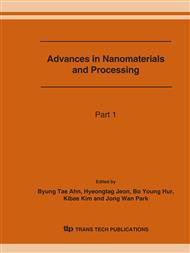p.1285
p.1289
p.1293
p.1297
p.1301
p.1305
p.1309
p.1313
p.1317
Fabrication of Size Controlled Nanohole Array on III-V Semiconductor Substrate by ICP-RIE Using Nanoporous Alumina Mask
Abstract:
Formation of size controlled nanohole arrays on semiconductor substrate can be used variously in applications of photonic and electronic device. The unique structure of nanoporous alumina was directly used as an etching mask for pattern transfer into the GaAs substrate. Using the alumina masks prepared at the anodic voltage of 24 V in 0.3 M sulfuric acid solution and 40 V in 0.3 M oxalic acid solution, fabricated were the arrays of nanohole on GaAs substrate by inductively coupled plasma reactive ion etching (ICP-RIE). The etching was conducted in a SiCl4/Ar mixed gas system. The uniform nanohole arrays were formed as replica of ordered lattice pattern of the mask. Depending on property of the alumina mask used, the size of nanohole was controlled to have hole diameter of 60 nm (with the hole density of 1.0 x 1010 cm-2) and of 30 nm (with the hole density of 2.7 x 1010 cm-2), respectively. So, the alumina mask attached on the GaAs substrate mainly determines the distribution and the size of the nanohole arrays. ICP-RIE using nanoporous alumina masks can control the size and the density of nanohole on compound semiconductor substrate.
Info:
Periodical:
Pages:
1301-1304
Citation:
Online since:
June 2007
Authors:
Keywords:
Price:
Сopyright:
© 2007 Trans Tech Publications Ltd. All Rights Reserved
Share:
Citation:


